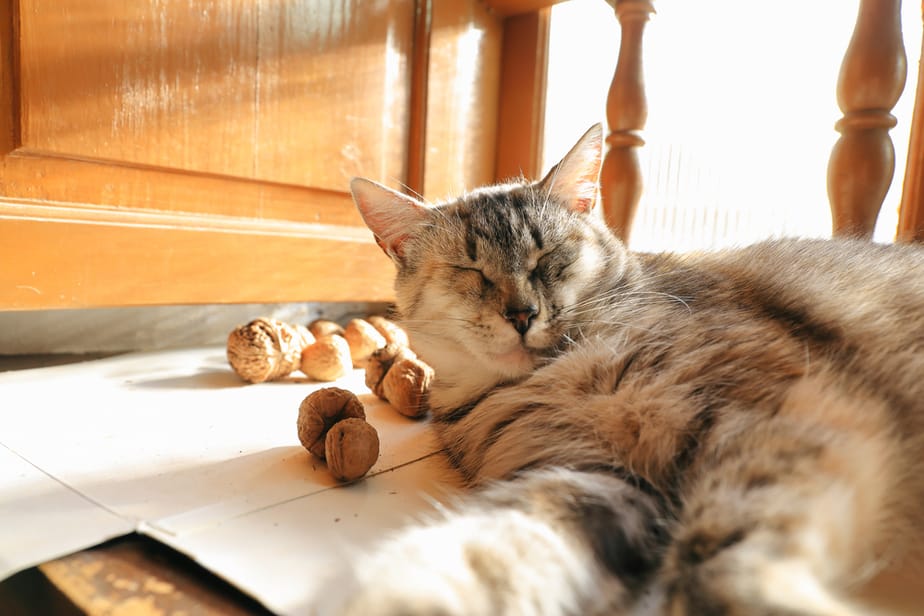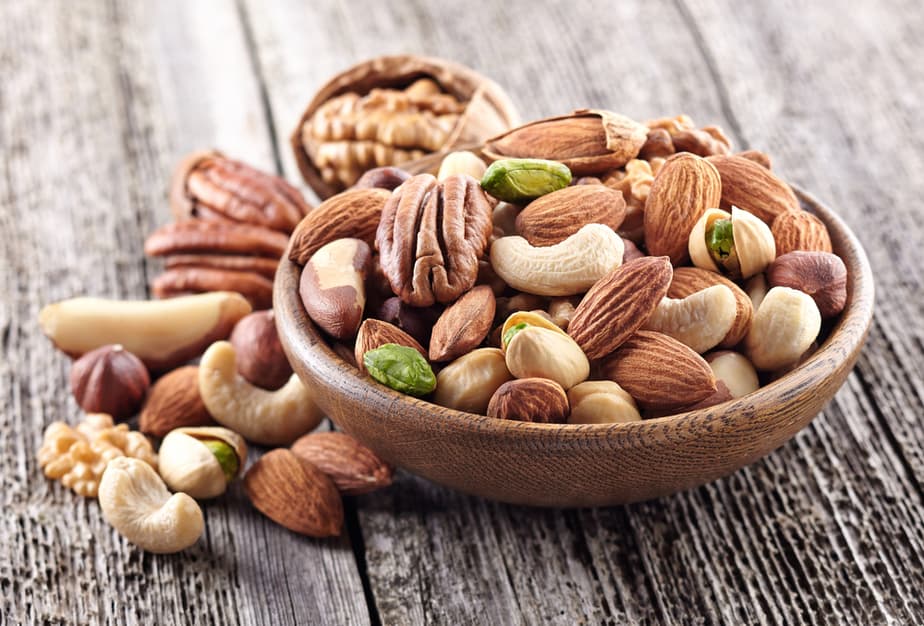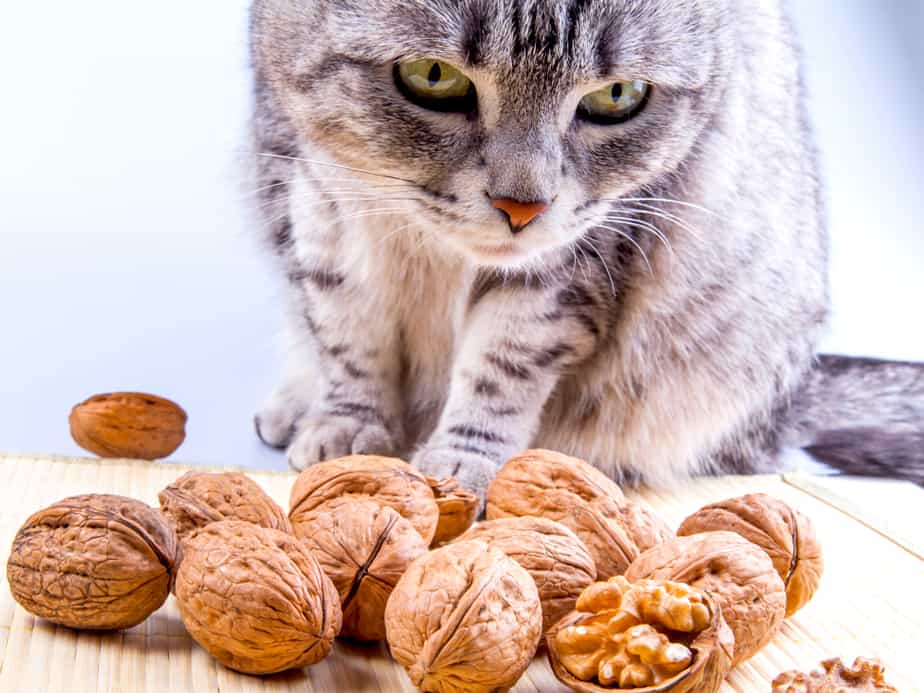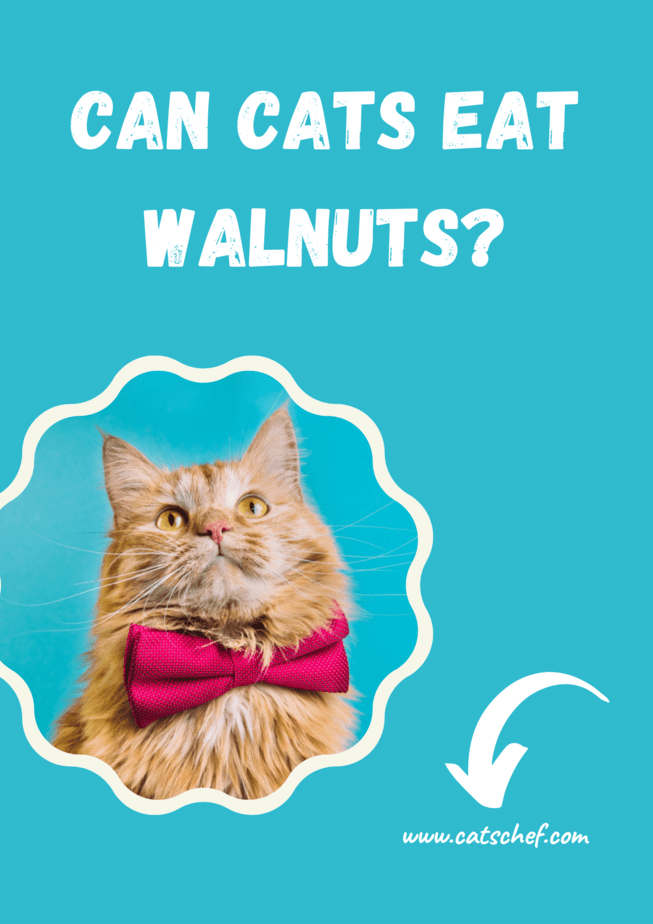📖 Table of Content:
Every walnut lover out there knows the feeling of opening your kitchen cabinet and seeing a mysterious, furry monster munching on the nutty treats like there’s no tomorrow. Or at least every walnut lover who owns a cat… So, can cats eat walnuts?
You shouldn’t be surprised if your curious creature starts showing a sudden interest in this superfood. Cats are incredibly predictable when it comes to food. They eat meat, animal protein, animal-sourced vitamins, minerals, and antioxidants… And everything they see you put in your mouth!
Look at any cat owner’s search history and you’ll see “Can cats eat walnuts?”, “Can cats eat Doritos?”, or even “Can cats eat leftover lasagna!?” You simply can’t argue with the fact that your cat is bound to eat anything she can get her little paws on.
The only thing you can do about it is hope she didn’t eat something that’s going to cause her harm. The best way to avoid these situations is to make sure to keep an eye on her at all times.
You should also provide her with plenty of nutritious cat food so that she doesn’t feel the need to sneak into your pantry and steal your food. And, you shouldn’t panic if she happens to eat a walnut or two! Walnuts aren’t toxic to cats, but…
You shouldn’t let her go overboard because her digestive system doesn’t contain the necessary enzymes to break down fruits, veggies, or nuts. In fact, you shouldn’t let her eat walnuts at all!
So, can cats eat walnuts?
According to the ASPCA (American Society for the Prevention of Cruelty to Animals), walnuts aren’t toxic to cats. This would be a great moment for your mischievous monster to meow in celebration, but… There are so many reasons why she shouldn’t eat them.
On one hand, these nutty treats are incredibly beneficial to humans. They’re rich in antioxidants and omega 3 fatty acids, promote a healthy gut and decrease inflammation, lower blood pressure, prevent heart disease, and help maintain a healthy weight.
But on the other hand, your stomach is much larger than that of your four-legged friend. Walnuts have such a negative impact on your cat because she has a tiny digestive tract, and she isn’t able to break them down the same way you would.
Large amounts of walnuts might cause immense harm to her digestive system. She might experience symptoms of food poisoning such as a loss of appetite, abdominal pain, stomach upset, diarrhea, and vomiting. It’s safe to say you shouldn’t feed walnuts to your feline friend!
Reasons why you shouldn’t feed walnuts to your cat
You’re still googling “Can cats eat walnuts?” First things first, walnuts aren’t the worst thing your cat can put in her mouth. They’re rich in nutritional and health benefits and they contain heaps of vitamins, minerals, and antioxidants.
In fact, walnuts contain vitamin E, polyunsaturated fat, and polyphenols which are responsible for your cat’s healthy brain function.
Among all the other types of nuts (macadamia nuts, hazelnuts, pecans, cashews, pistachios…), walnuts contain the largest number of nutrients which should make them an excellent treat.
However, there are numerous reasons why your cat shouldn’t consume these nutty treats. Not only are they difficult to digest, but they are also incredibly high in fat and sodium content. Too many walnuts might not be the best idea for your cat!
1. Walnuts are high in fat
Repeat after me “Fat is bad for your cat!” You might think a bit of fat here and there shouldn’t cause any adverse reactions to your feline friend, but… Consuming food with high-fat content isn’t safe in the feline world.
What do we mean by that? Well, if your feline friend accidentally consumes too many walnuts she might experience serious digestive issues. Her symptoms might range anywhere from a loss of appetite, lethargy, and weakness to stomach upset, diarrhea, and vomiting.
You see, a small serving size of walnuts contains around 65 grams of fat. That’s simply too much for your cat’s tiny digestive system to process. If she continues consuming too many walnuts and other foods that have high-fat content, she might develop serious diseases like pancreatitis.
Pancreatitis refers to the inflammation of the pancreas. It occurs when the pancreas releases digestive juices but they don’t end up in your cat’s digestive system. They turn to your cat’s organs and start digesting the tissue.
If you notice any symptoms of abdominal pain and discomfort you should contact your vet!
Lastly, foods that have a high-fat content might cause your feline friend to gain weight. While you might think she looks adorable with all that extra fluff, feline obesity is incredibly difficult to overcome. It’s better to be safe than sorry, so you might want to hide that secret stash of walnuts!
2. Walnuts are high in sodium
Cats LOVE the taste of salt. They are naturally drawn to salty treats because they’re pretty much the only things they can taste. Cats have very few taste receptors – while humans pride themselves in having around 10000 taste buds on their tongues, cats only have around 480.
But, your cat shouldn’t consume too much salt! If she does consume foods that are high in sodium, she might experience some side effects such as vomiting, diarrhea, decreased appetite, lethargy, incoordination, and excessive thirst or urination.
These are symptoms of sodium toxicity or sodium ion poisoning, and if you notice any of them you should contact your vet immediately. He should be able to provide your cat with proper medication and care, as well as induce vomiting in case her symptoms become severe.
What happens if your cat accidentally consumes too many walnuts? Well, she might experience uncomfortable digestive issues but you shouldn’t be worried about sodium poisoning as walnuts don’t contain enough sodium for that to be an issue.
However, if she continues consuming walnuts over a longer period of time she might be at risk of developing kidney, liver, or heart disease. And in severe cases, she might even experience kidney failure, which would inevitably lead to death.
It’s safe to say you should be incredibly careful with what goes into your cat’s mouth. At the risk of repeating myself, you should contact your vet immediately if you notice any signs of digestive discomfort, diarrhea, or vomiting. It’s better to be safe than sorry!
3. Walnuts are incredibly difficult to digest
Cats are obligate carnivores and they require meat, animal protein, and animal-sourced nutrients in their diet. This also means that they don’t require any fruits, veggies, or nuts unless it’s in form of an occasional treat.
Because of this, your cat’s digestive system doesn’t contain the necessary enzymes to break down and process walnuts. So, if she decides to have a feast in your secret walnut stash, she might have a hard time dealing with the aftermath of her decision.
While there are so many reasons why you shouldn’t include walnuts in your cat’s diet, this one should definitely be at the top of the list.
If your curious creature consumes too many walnuts, she might experience vomiting, diarrhea, loss of appetite, lethargy, tremors, seizures, excessive urination and thirst, pancreatitis, and kidney failure. Not only that, but she might also experience allergic reactions or food-related poisoning.
If you’re still looking for an answer to your “Can cats eat walnuts?” question, you came to the right place. After everything that’s been said about the risks and benefits of walnuts, it’s safe to say you shouldn’t let your cat feast on this nutty treat.
There are so many healthy alternatives on the market, and there are simply no good reasons why you should include human foods in your cat’s diet. Trust me, she’s better off without any walnuts in her tiny stomach!
Can cats eat black walnuts?
As if regular walnuts weren’t enough, your curious creature suddenly decided to show interest in every single nut in this world. If you’re a pet owner, you’re familiar with the power of the infamous goo-goo eyes… So, can cats eat black walnuts?
First things first, black walnuts are not your typical walnuts. They stand out because of their distinct flavor, incredible versatility, and impressive list of nutritional and health benefits.
In fact, black walnuts contain the most amount of plant protein out of all other types of nuts which should make them a great treat for your cat.
But, cats shouldn’t eat black walnuts. While they aren’t considered toxic to cats (according to the ASPCA), they could lead to adverse reactions if consumed in excessive amounts and over a long period of time. They are incredibly high in fat and sodium, and they are difficult to digest.
In addition to that, black walnuts have the hardest shell among all other types of nuts. It’s so hard that it’s used in a wide range of industrial applications! But, what does that mean for your cat? Well, black walnut shells can be quite a choking hazard!
If she tries to eat a black walnut before it’s been properly cleaned, the shell might get stuck in her throat or even her digestive tract. Not only will she be incredibly uncomfortable, but she might even experience digestive issues such as stomach upset, diarrhea, and vomiting.
So, black walnuts might not be on the list of toxic foods, but it’s safe to say you shouldn’t include them in your cat’s regular diet. And in case she accidentally consumes this dangerous nut, you should contact your vet immediately.
And what about chocolate walnuts?
Chocolate walnuts are one of the most popular healthy treats for humans. They’re incredibly easy to make because the only thing you need to do is cover your walnuts in some melted dark chocolate and sprinkle them with a generous amount of sea salt. Delicious, right?
Well, your four-legged friend would probably say “wrong”. Not only is the safety of walnuts up for discussion, but chocolate might be the worst thing you can feed to your cat. Believe it or not, chocolate is toxic to cats. Here’s what your need to know!
Chocolate contains ingredients called theobromine and caffeine which are the main reasons why it might have such hazardous effects on your feline friend. Unlike caffeine, theobromine is absorbed into your cat’s system much more slowly, meaning that even a small amount could be lethal.
You should keep an eye on symptoms of chocolate toxicity such as hyperactivity, restlessness, increased heart rate, vomiting, diarrhea, excessive thirst and urination, tremors, seizures, muscle rigidity, and overall weakness. If you notice any of these symptoms you should contact your vet immediately.
And if that wasn’t enough, they had to include sea salt in the recipe! While sea salt isn’t toxic to cats, excessive amounts might lead to various digestive issues.
On the off chance that your cat manages to eat such a large amount of chocolate walnuts, she might even experience symptoms of sodium poisoning. Vomiting, diarrhea, excessive thirst and urination, incoordination – if you notice any of these symptoms you should contact your vet.
That being said, can cats eat chocolate walnuts? Absolutely not! Your feline friend isn’t a huge fan of sweet things, so she shouldn’t be too gutted when you tell her the news. There’s no reason why she should pine for these nuts!
And what about other nuts?
We’re still on the topic of nuts? Here’s the thing – feeding your cat with nuts is generally not the best idea you can have. Most nuts are incredibly high in fat, sodium, and calories which makes them a poor choice for your cat.
Additionally, most nuts are a choking hazard. You shouldn’t be surprised if one of them gets stuck in your cat’s throat, esophagus, or intestines. Your cat might even experience some serious digestive issues including stomach upset, diarrhea, and vomiting.
That being said, some nuts are worse than others. You shouldn’t include any of them in your cat’s regular diet, but you might be able to include some of them as an occasional treat. So, if your cat happens to be a huge fan of nuts, you might want to take a closer look.
Macadamia nuts, pecans, and pistachios fall under the category of nutty treats you might want to avoid. While macadamia nuts aren’t toxic to cats, it’s best to keep them out of your cat’s reach. They might cause lethargy, hypothermia, vomiting, and diarrhea if consumed in excessive amounts.
Pecans might be a bit safer for your four-legged friend, but you still shouldn’t include them in her regular diet. Too many pecans might cause digestive issues with symptoms such as abdominal pain, diarrhea, and vomiting.
Pistachios might be the worst out of the bunch. They contain a bunch of sodium, additives, and preservatives because they’re typically prepackaged. It’s safe to say you should avoid feeding them to your cat if you don’t want her to spend most of her day in her litterbox!
Don’t worry, there’s still hope for your nut-loving feline friend. Cashews, hazelnuts, and chestnuts are generally safe for feline consumption. An occasional nutty treat shouldn’t cause any adverse reactions!
Can cats eat walnuts? Final verdict!
According to the ASPCA (American Society for the Prevention of Cruelty to Animals) walnuts aren’t toxic to cats. But, before your mischievous monster starts celebrating it’s important to mention that walnuts don’t come without any risks.
Unfortunately, they are incredibly high in fat and sodium. Your cat’s digestive system doesn’t contain the enzymes necessary to break them down, which makes them difficult to digest. Consuming too many walnuts might leave your cat with digestive discomfort, pain, and nausea.
It’s safe to say that you should let your feline friend go ham in your secret stash of walnuts. If she’s such a big fan of nutty treats, you might want to look for commercially available cat treats with a similar taste and texture. Or, you might even want to swap them for cashews, hazelnuts, or chestnuts.
Whichever route you decide to take, good luck!









